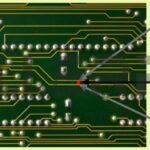Printmaking offers a fascinating array of techniques, each yielding unique artistic results. Among these, relief and intaglio stand out as fundamental methods, distinguished by how ink is applied and transferred to paper. This exploration delves into the world of relief and intaglio printing, using the versatile carborundum plate as a medium to clearly illustrate the contrast between these two approaches. By examining the textures of a single plate and how different inking methods interact with them, we can unlock a spectrum of visual possibilities.
Understanding Relief Printing: Inking the Surface
Relief printing, as the name suggests, involves inking the raised surfaces of a plate. Imagine a rubber stamp – the ink sits on the raised design and is transferred to the paper when pressed. In relief printmaking, areas that are carved away or recessed do not receive ink, resulting in the image being created by the inked, raised portions.
With a carborundum plate, which is often made from applying carborundum grit to a base, the rough texture of the carborundum creates a surface that, when inked in relief, behaves in a particular way. When a roller is lightly inked and passed over a carborundum plate, the higher, smoother areas tend to pick up more ink and print darker, while the rougher, more textured carborundum areas may receive less ink on their topmost points, printing lighter. This is because the roller primarily makes contact with the highest points of the plate.
Consider a plate with varying textures, such as one made with carborundum paint, smooth card, and bare mountboard. In relief printing, the smooth card areas would likely print darkest, the bare mountboard a medium tone, and the rough carborundum the lightest, creating a tonal range based on surface height and texture interaction with the ink roller.
Exploring Intaglio Printing: Inking the Recesses
Intaglio printing, conversely, involves inking the recessed areas of a plate. The word “intaglio” itself comes from the Italian word “intagliare,” meaning “to incise.” In this technique, lines or textures are etched, engraved, or, in the case of carborundum, created by the texture itself to hold ink. The surface of the plate is then wiped clean, leaving ink only in the grooves and textures. When printed under high pressure, often using an etching press, the paper is forced into these inked recesses to pick up the image.
When inking a carborundum plate for intaglio, the process is quite different from relief. Ink is pushed into all the textures and crevices of the plate. Then, the surface is wiped, removing ink from the higher surfaces but leaving it nestled within the rough carborundum and any other recessed areas. In this intaglio process, the rough carborundum areas become ink reservoirs, printing dark and rich, while the smoother, wiped surfaces print lighter or even white if thoroughly cleaned.
This results in a tonal reversal compared to relief printing. The rough textures that printed light in relief now print dark in intaglio, and the smoother areas that were dark in relief can become light in intaglio.
Compare and Contrast: Key Differences in Relief and Intaglio with Carborundum
| Feature | Relief Printing | Intaglio Printing |
|---|---|---|
| Inked Area | Raised surfaces of the plate | Recessed areas of the plate |
| Surface Texture & Tone (Carborundum) | Rough areas print lighter, smooth areas print darker | Rough areas print darker, smooth areas print lighter |
| Inking Method | Roller is used to ink the surface | Ink is pushed into recesses and surface is wiped |
| Pressure | Generally less pressure required | High pressure press is typically needed |
| Tonal Values | Highlights are textured areas, shadows are smooth | Shadows are textured areas, highlights are smooth |
Combining Relief and Intaglio: Expanding Creative Potential
The true versatility of carborundum plates is revealed when relief and intaglio techniques are combined in a single print. By first inking the plate in intaglio, filling the textured areas, and then rolling a different color of ink over the surface in relief, a printmaker can achieve complex, multi-layered images.
This method allows for nuanced color interactions and textural depth. For example, wiping the surface after intaglio inking but before relief rolling can create white or lighter areas in the final print, adding another layer of complexity. The combination of techniques from a single plate opens up a wide spectrum of artistic expression.
Ghost Prints and Continued Exploration
Even after initial prints, the carborundum plate continues to offer possibilities. “Ghost prints,” created by running the plate through the press again without re-inking, can produce softer, paler versions of the image. These ghost prints can then be further enhanced by adding another layer of relief ink, as demonstrated in the example below, creating subtle variations and building up layers over multiple passes.
The beauty of working with carborundum and exploring relief and intaglio is in the element of surprise and discovery. As you experiment with different color combinations, inking pressures, and layering techniques, the same plate can yield an astonishing variety of prints, each with its own unique character and visual story.
Embrace Experimentation
Understanding the fundamental differences between relief and intaglio printing, especially when applied to a textured surface like carborundum, empowers printmakers to push creative boundaries. By embracing experimentation with inking methods and color, artists can unlock the full potential of a single plate, continually surprising themselves with the diverse and captivating prints that emerge. The key is to approach the process with curiosity and a willingness to explore the interplay between texture, ink, and technique.

